President’s Note
Rajeev Annaluru
2012 marks 21 years of Asha. Since its inception, Asha for Education has funded 800+ projects across 24 states in India and disbursed in excess of $25 million. In 2012 alone, Asha disbursed more than $2 million and supported the education of more than 100,000 kids directly and many hundreds of thousands more indirectly. Asha is a unique organization, in that, it has achieved all this through volunteers only. In that regard, Asha is one of the truest examples of a successful crowd-sourced organization.
But at the core, Asha is not just a funding agency. It is an awareness platform and an action group. Volunteers in Asha have the opportunity to connect with the grassroots in India at a very intimate level. The deep understanding that volunteers gain about the fundamental and systemic issues that are hindering the socio-economic progress of the marginalized communities is eye-opening and life-changing. Empowered with this understanding, they engage with the projects not only as peers but also as facilitators of much-needed resources and solutions.
2012 brought a change of guard in the Asha-wide coordination team. This is a small team of dedicated volunteers who handle administrative and compliance issues common to all chapters in Asha. After introducing significant improvements like the Asha Representative Council (ARC) reform, the previous coordination team handed the baton to the current team in June 2012. Looking ahead, the current team has both significant opportunities and challenges that it is looking to take on.
Last year we took a big leap in the world of social media. We actively used our Facebook and Twitter channels to engage with our audience. Our Facebook campaign for Work an Hour fundraiser helped us reach our fundraising goals and expand our fan base to more than 10,000 people from across the globe. We will be looking to build on this success to constantly converse with our audience about the great work happening in Asha.
We also had an Asha East coast conference. Six chapters on the East Coast of US, met for a couple of days to discuss various operational issues. Personally, it was my pleasure to meet a passionate bunch of volunteers and brainstorm on their problems.
The 100% crowd-sourced operating structure of Asha brings both significant advantages as well as challenges. Amongst the major challenges is the issue of volunteer recruitment and retention. In a survey done about two years ago we found that the average retention period of an Asha volunteer is 2.5-3 years. At a time when many Asha chapters are finding themselves severely constrained for volunteer bandwidth to run their regular fundraising programs and projects, we need to seriously re-think ways to constantly bring in new blood into the organization as well increase the retention period of existing volunteers by making their time and efforts more impactful and enjoyable for both the volunteers as well as for the organization.
Asha will be looking to institute new volunteer recruitment campaigns to tap into the massive pool of talented Indian diaspora spread across many cities where Asha’s chapters are located. It is vital for Asha to ensure that the chapters always have a critical mass of passionate and engaged volunteer base who share the organization’s vision. We should also institute training and engagement programs that will help volunteers understand the fundamental realities of the educational and socio-economic distortions we seek to rectify. Simultaneously, we will be looking to undertake improvements in internal processes in treasury, IT and projects teams to maximize efficiencies.
As I look ahead, I can only feel excited about the opportunities for not only taking part in vital grassroots work in India but also for the upcoming changes to the organization to improve efficiency and affect growth.
I would also like to express my heartfelt thanks to all the donors of Asha without whose support we wouldn’t be what we are.
Through this annual report, I present various essays and reports written by our volunteers that testify to the passion and enthusiasm that each Asha volunteer brings to the organization. I hope these will help you to not only understand the grassroots issues that Asha deals with but also provide a flavor of what Asha is at its core.
Prakruti Badi – Timbaktu Collective
A site visit report by Sanjeev Ranganathan, Asha Bangalore
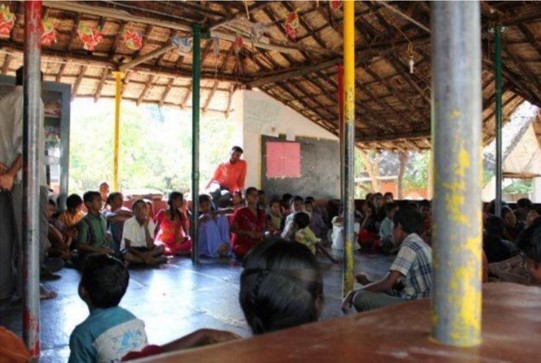
I visited Prakruti Badi(PB) in Timbaktu, Andhra Pradesh, from 11 to 14 December 2012. Asha Bangalore has a SAC (Support-a-child) program since last May and I wanted to spend some time with the kids as well as understand the functioning and challenges of the school and residential home.
I spent the first day going through administrative aspects of the school with Vaneeta (coordinator at PB) including the finances of the school. There are 55 residential and 28 day scholars at PB. Last year, the SAC program raised 12 lakh rupees for the residential kids, Timbaktu also raised almost 10 lakh rupees for the day scholars. However, they had a deficit of four lakh rupees last year. This deficit, coupled with the rising food costs, has made finances very tricky this year.
Day 2- Interacting with the kids: I spent the next day interacting with the kids during school. I attended the morning assembly which was quite interesting. It is different from assemblies in other schools, which have poetry/shlokas, a pledge, news, etc. Here, the time was marked for a discussion with students and teachers on anything they may consider important. A week ago, in an assembly, a child had questioned what constitutes rules, personal responsibility, etc. This led to a more involved discussion about various activities that children and teachers undertake at PB and how they can be classified. In addition, they came up with things they would like to improve at the school and how their ideas can be implemented. Two days later, when I attended the assembly again, the discussion was wrapping up. Committees of children were formed towards working on some of the issues identified. The broad idea of the assembly is to involve the children in critical thinking and decision making, as it seems impossible to run a child-centric school without children taking up some responsibility of at least the small things.
After the assembly I went with Vaneeta to her classes. This gave me an opportunity to interact with the children from 5th to 8th grades. Vaneeta graciously let me take over her classes. I had brought a game, quarto, for the kids. It can be explained and learnt quickly and played by a very wide age group. At the same time, it requires thinking in unconventional ways. Vaneeta and I played the first demo game to help explain the rules and then let the children take over. It was interesting to see kids interpreting the rules in their own way. The older children stuck to the format initially explained though a few of them were also making new strategies. I also modified some rules so that the game could be played longer. This helped prolong interest in the game. The endearing aspect of this exercise was that children did not care much about winning or losing but were happy when they played well.

Since the game can only be played by two people, I also took along a bunch of metal disentanglement puzzles. I find puzzles and games a great icebreaker with kids allowing me to interact with them despite language issues and learn about them. It was nice to see that the children were eager to try out something different. I too had not worked on these puzzles for a while and had fun solving them. It was nice to see the moment when it “clicked” for them and they finally figured out how to solve the puzzles. Vaneeta and Anna (an intern) also solved the puzzles along with the kids and were persistent in their efforts. However, some children gave up a little too early and were eager to master the solving technique by asking me to repeatedly solve the puzzles.
There was a break after the first two classes and children played in the playground during the break. They were cheerful and easy to engage with activities. One could not differentiate between the residential children and the day scholars. Many of the residential children come from very humble backgrounds but seemed happy and not burdened with emotional baggage.
The children had recently built an obstacle course using waste materials from the school with Anna’s help (see below). The task was to enter from one end and exit at the other without touching the ground. This involved balancing on tires and bamboo poles, swinging from ropes and jumping into nets. The structures were not too high – so it was safe – and had been built to take my weight. (No, I didn’t finish.)
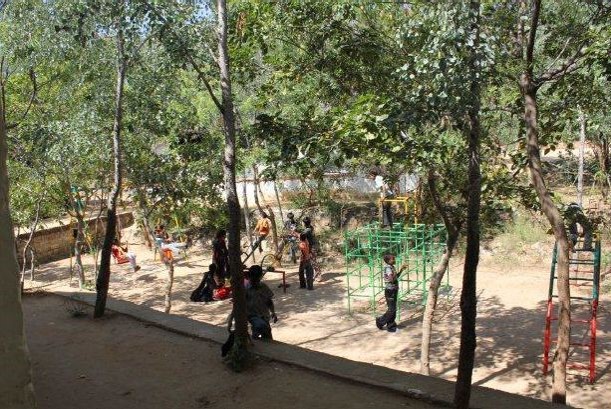
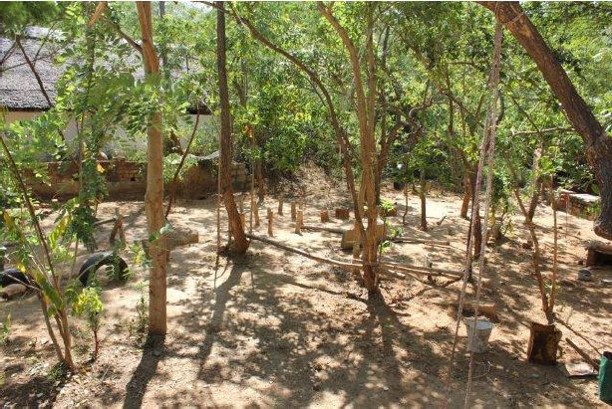
Structurally, most classrooms were open and roomy. A couple of structures had solid or tiled roofs while others had thatched roofs. The school will need to put in some investment to meet RTE regulations of “permanent buildings”. Thankfully, there is ample space for the student strength. The main hall where they meet for assembly also has a store for sports material, arts & crafts material and lab material. The roof of the store room is tiled to keep moisture out during the rains. The dorms are simple with segregated sections for boys and girls. There is a lot of space outside the rooms and this is used for grades 1-3 as classrooms. The artwork on the walls all across Timbaktu has been done by the kids as part of their arts & crafts exercises. The children also have gardening, games, sports and music classes during the afternoons.
Day 3-Delving deeper: Having interacted with the children on the previous day, I reckoned they would be comfortable to let me attend classes. I decided to sit in the math classes as language subjects are not too difficult for the kids. I attended the 8th grade math class where they were solving linear equations in two variables by getting the corresponding lines on the graph paper and finding the point of intersection. (It is interesting that though the girl:boy ratio in the school as a whole is 1:1, some grades have mostly boys and some have mostly girls. The 8th grade, for example, has only girls and the 5th has only one girl and seven boys. The class-strengths are small and easily manageable, with an average of eight children per grade, though the younger grades, i.e., 1st-3rd, have a few more kids.)
The theory behind what they were doing had apparently been covered in earlier classes and the girls were trying to solve a few problems in this class. While two girls who had joined the school only a few weeks ago were trying to find their way around, a couple of girls seemed to be clear about the technique. They were writing y in terms of x and substituting values of x to get the value of y, writing it as sets of (x, y) and then plotting these for the two equations. The process was taking some time: They were trying to get six points for a line and after 10 minutes one of the girls got four points correctly but was confused about the other points. She attempted to draw two lines for the same curve.
At this point, I asked the teacher if the girls understood what a linear equation was and how a straight line represented it. I asked the girls (with a teacher translating for me) what a straight line was. The girls answered the following, “A line is a line.” “Ok, fair enough,” I thought. I wasn’t looking for a bookish definition anyway. I asked them how many points were actually required to draw a straight line. One girl promptly declared six and others agreed.
I drew three houses A, B, C and asked for the shortest way of getting from A to C, a girl drew a straight line not going through B. Then they enquired about B. I asked them for the shortest way from A to B and B to C, they drew two more lines. I erased the houses and replaced them with points and they were still ok with these lines. When I asked them how were they able to draw the line with only two points if six were required, they began to think.
Unfortunately, with math it is easy for a student to interpret a technique but make a mistake while using it if he or she has not understood the thought behind the technique. Actually, the entire purpose of the graphical method of solving an equation is to allow a mental picture of a linear equation, e.g., what would x – y = 2 look like on a graph and, further, what it means to solve two linear equations. I suggested that if only two points were required and minimal calculation was involved, it would reduce errors. I suggested using the x and y intercepts (making x zero and use the value of y and vice versa) as the two points. We tried a problem and they understood the method and were able to solve a problem in the remaining time.
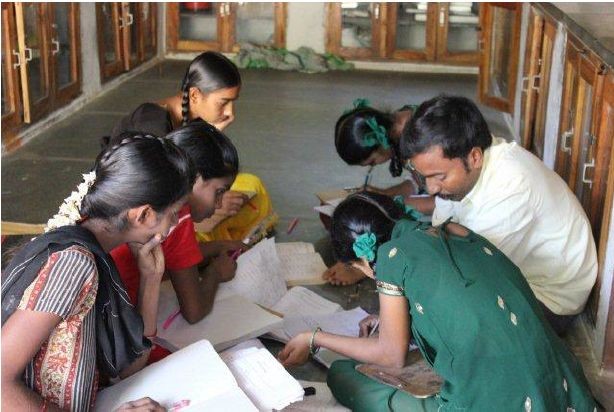
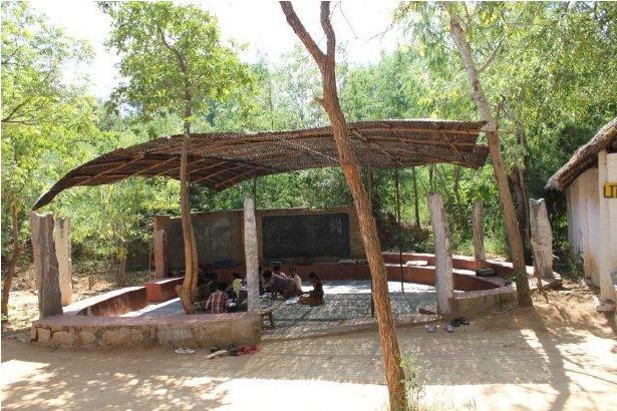
I had a more detailed chat with the teacher in the next class as the 5th graders were allowed to work on whatever they wanted to and they asked for my puzzles and games. I discussed with the teacher that x, y intercept is also only a “technique” and has its limitations. However, the process would go faster and they may have a chance to finish a few problems and get the hang of how curves should look given an equation. Of course, it is still possible that children make a mistake but they could cross check if the solution point fits both equations.
The next class was with 7th graders. Some children were quite keen on playing with the puzzles but I gently yet firmly indicated that I was planning to sit in the class. In this class the children were solving single variable equations. Some of the children seemed to have already finished the worksheet and were waiting while the others labored over their problems. Given the large differences in learning capacities of the children, the teachers need to figure out a way to engage all the children. I gave a verbal problem to the kids sitting around: There are unknown number of cows; one was given to M and the rest were divided in two; one half was given to K and the other one was left with 4. I wanted the children who had finished to give me the equation for the same.
A boy in the class solved it intuitively and since the problem was a simple one, this was fine. However, by this time all the children were excited and wanted to participate in what was going on. With the teacher’s permission I gave them an easier problem: There are unknown number of oranges; out of these, 2 are removed and we are left with 5. The kids latched on to this and I asked them to write an equation and tell a story about the same. Again, some kids finished quickly and I asked them to continue making more stories on equations while everyone finished. The kids seemed generally comfortable to come forward and tell their stories and write the equation on the board. A couple of children had to consult their notes for the equation but most had enough short-term retention to create a story, its problem and retain it till the end. We were running out of time, but I wanted to demonstrate the power of writing equations, so I modified my original story: From an unknown number of cows, one cow is given to M, half of what was left was given to K, half of what was left was given to J, half of what was left was given to N and there was still one left. Guesswork was not working out and just as the bell rang a girl said she figured it out and wrote the equation ─ (x-1)*½*½*½ =1 ─ on the board solving x as 9. It was impressive and left me hopeful that it is possible for the children to connect the dots and understand what they were doing.
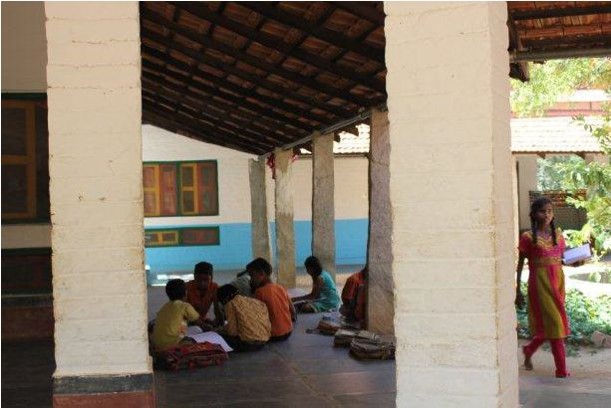
I then spent some time in the 1st to 3rd grades math classes. They were working on their worksheets, some with a teacher, some on their own. Some children were much older than the others but had not been in any school before coming to PB. They were being helped to master the skills rather than be put in an “age appropriate” grade where they would be lost. They seemed comfortable with the younger children and were busy with their worksheets. In math there is a fair bit of emphasis on doing worksheets. Though rigor is necessary to master math, repetition with worksheets is not rigor if it comes without understanding the concepts. Given that the children are quite excited during classes with activities and not preparing for examinations (where substituting a formula may be enough) these classes should be taken very differently.
The day incorporates many activities, including games, gardening, music and art, but I felt a 40-minute class does not allow enough progress. I also saw only one child working on a worksheet before the teacher got to class; so if the teacher is delayed by 5-10 minutes, the class was even shorter. Perhaps a creative method in which alternate classes are longer can be used with longer classes to work on concepts and shorter ones for children to independently solve worksheets. The teachers seem to be doing something in almost all periods. It would help if the children are able to work independently and give the teacher time to prepare for her class.
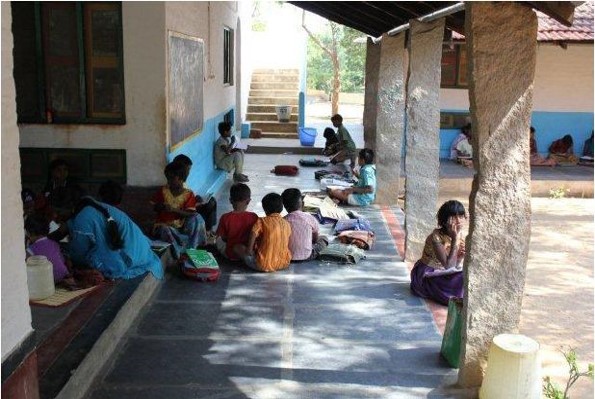
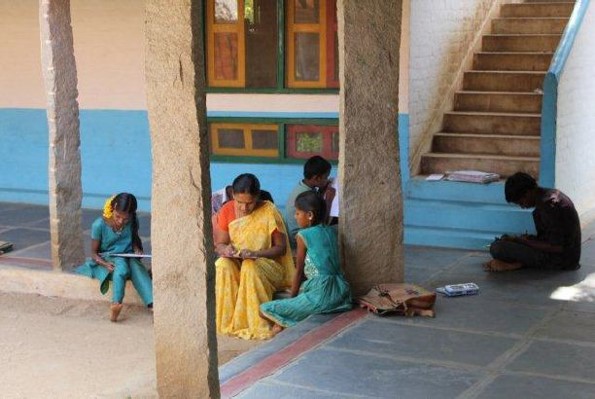
Discussions with management at PB: PB is a good home for the residential children (children at risk). They were happy and comfortable with their teachers. The children were in learning-appropriate levels rather than age-appropriate levels. The number of children in a class was small (eight on average). There were a lot of activities including art, crafts, games and gardening. Even though children were in learning-appropriate levels, there was sizeable disparity in learning abilities within a class. The teachers did not seem to be trained to cope with this disparity even though the class strength was low. The textbook was still king and all children were trying to learn at the same level. Although the children were comfortable with the teachers, they did not question what was being taught. I spoke of my observations regarding math and Vaneeta acknowledged that teachers, for the most part, relied on rote for academics.
Vaneeta spoke about her idea of an alternative school being one that got children to participate and think in all activities. She talked about the assembly changes – from a presentation style to a discussion-based style – as being a part of this goal. She feels it is important for her to interact with the children as it gives her a handle of how things are. She also feels that as a teacher she is able to get the children to open up, think and be creative in her classes. We talked about her dilemma of working with younger children to strengthen their basics when they go to higher classes, but the fact remains that there are already children in higher classes who need support. She also mentioned that it helps when volunteers like Anna visit to do something concrete with the kids, for example, the obstacle course.
There are also many other challenges. The limited number of teachers requires them to take 7-8 classes in a day leaving them with no time for planning and training. If even one of the teachers is on leave it throws the planning off and impacts the classes. If a child falls sick or has surgery, a teacher has to be with it if it is taken to Ananthapur or Bangalore for treatment. Moreover, teachers are also wardens; so they have to spend time with the children after school.
There is absenteeism when day scholars may miss a week or two of classes due to things at home and feel cut off when they come back. In the last two days of every month, there is a Timbaktu Panchayat (meeting) where all the projects in Timbaktu meet and update each other on happenings of that month. The school is closed at this time and other than the teacher presenting for PB (she encourages the teachers to be present) the other teachers are on leave and the residential children visit their family. Unfortunately, at times some children do not come back by the first of the month. These children miss out on these days and sometimes a teacher needs to go to their villages and bring them. Timbaktu has also taken up the responsibility of a couple of girls who were at risk and there will be teachers who will need to be with them throughout the summer holidays as well. She felt that any training would need to be in house with someone attending classes and giving inputs. She requested me to come for a week and work with the math teachers.
We discussed the efforts for registration of the school as a residential bridge school. This would still only give the school access to kids for about 11 months, with an extension of 11 months, by which time, they would have to be a formally registered school. 3/9 teachers have a BEd degree as is required for the strength of children they have now. The school is located on Timbaktu’s public land and has a fair number of rooms. However, thatched roofs have to be converted to tiled roofs in some buildings. Vaneeta feels that there is scope to make PB a good alternative school, but the work requires patience and time.
Asha and I
Protima Pandey, Asha Silicon Valley
I hope as a child you didn’t have to choose between going to work on the fields and going to school. I hope you didn’t have to walk many kilometers to the nearest school only to come back home with no lights to read or do your homework under. I hope you didn’t draw blank stares from your parents when you asked for help with school, because they had no answers to give you regarding your ability to go to school, their ability to send you to school or the state’s ability to even provide you with a school. I also hope that as a parent you don’t have to choose between sending your able child to school or providing services for your disabled child. This is a snapshot, a mere glimpse of some of the difficult daily choices made by many around the world.
To people with these choices, “hope” is a word that is truly utopian. To some of those struggling like this, Asha for Education provides the necessary tools to overcome the lack of access to education. Incidentally in the Hindi language, the word Asha means hope. The mission of Asha is to use education as a catalyst for socio-economic change. For the thousands who receive funding through Asha, it is a life-changing experience. But I don’t want to focus on how their lives have been touched by our work. What I wanted to do with this space was to describe my life as an Asha volunteer. My first Asha meeting was in a grad-school classroom at Washington University in St. Louis. I was overworked with studies, under-paid as a research-assistant and homesick being away from my family in India and my partner in another grad-school. I had no idea why I was attending the meeting except that some people I had met after arriving in St. Louis had invited me. Twelve years later, I can say that each week I spend about four to six hours of time I don’t have on various Asha related tasks. My family, my friends, my six-year-old, my co-workers, neighbors and even the lady who hit me with her car know the special place I have in my life for the work that I do with Asha. That lady had hit me while she was backing out her car from a parking lot without looking first. I made her write a check towards Asha instead of compensating me because I did not get hurt. Did I mention I volunteer for Asha?
Here’s the part where this story gets completely mind boggling. In the last twenty years since its inception, Asha has disbursed upwards of $25 million raised worldwide to almost 800 schools in India, supporting underprivileged children. And we (Yes, I tend to say “we” a lot when I talk about Asha.) have done all of this with 100% volunteer time. No one is paid to stuff and mail envelopes, to photocopy dozens of publicity flyers for a fundraiser, to collect, store and assemble displays at events, to use frequent flyer miles for flying fundraising performers, to drive 100 miles to an Asha publicity booth at an event, and many more such things that require countless hours of actual time, commitment and work. The best part? Time is spent doing meaningful work that matters to the volunteer. The end goal of a smile on the face of a child attending a project partner school is priceless.
I work fulltime for a non-profit organization, I volunteer for Asha, and I also serve on two non-profit organizations’ boards. And yet the need to have people donate hours, money and expertise to non-profit organizations is greater now than it ever was. Money is short, time is scarce but remember that there are those who are not as fortunate as us, and helping them by finding time or money will be a small task for you but a life-change for those you have helped. I was asked by a friend recently for some ideas on volunteering and she quickly added that it has to be a weekend and preferably, an outdoor activity. I asked her to search within her life for a meaningful cause that mattered to her and then look for those who work on the cause she cares about. I asked her to contact the non-profit with her availability so they can use her generous offer to their advantage. I am sure, in no time, if she finds the cause that drives her, she will be moving full-steam ahead, no matter the day of the week.
Find your cause, there are plenty of good people who need your good expertise, your hard work and your dedication. No task is too small. Just know that whatever you do, you must connect to it so you can sustain yourself. I am, 12 years and going strong!
Janseva Mandal & Jeevan Vidya
Jave Dave, Asha Seattle
Janseva Mandal is located in the district town of Nandurbar in Maharashtra. It was founded in 1969 as a part of the Bombay Xavierant Corp (which also has a stake in Xavier’s College, Mumbai). Jeevan Vidhya is a branch of Nirmala Niketan, a women’s development institute. Both organizations have been working on tribal development for over 25 years. They initiated a dialogue with tribal communities to formulate strategies of economic and social mobility covering environmental conservation in farming, credit management and alternative education. Their primary approach includes inclusion of tribal youth in the development of their own communities on a semi-voluntary basis through motivation and training programs.
They provide boarding and lodging for 120 tribal children in Nandurbar. Janseva runs the facility for boys and Jeevan Vidya runs the girls’ facility. Asha has provided financial support to these organizations since 2008, accounting for approximately 40% of their food and living expenses annually. Thanks to Asha’s support, these organizations could focus on improving the facilities that they provide the children. These improvements include a computer lab with over 45 laptops, math and English classes, nutritious food, studying facilities for Janseva boys and solar heaters.
The academic year 2011-12 began on 15 June 2011. Jeevan Vidya admitted 16 girls to the 5th grade bringing up the number of students to 73. The number of boys in Janseva remained at 60. In addition to the work with tribal communities, the organizations have identified issues with the quality of primary education at the local schools where a number of students have difficulty with basic math. They have teamed up with another organization called QUEST to provide remedial classes in math to the students. QUEST provided a teacher trained to teach basic math to 5th and higher grades. The computer lab set up two years ago additionally benefits both organizations. A trained instructor teaches various software to the students based on their age, for example, MS Paint for students in the 5th grade and Excel worksheet for students in the 10th grade. In addition to education, the kids are also involved in agricultural work on campus. This serves the dual purpose of keeping them in touch with their agricultural roots and teaching them the dignity of labor.
On every alternate Sunday, both organizations organize various co-curricular activities and competitions for the students, like handwriting contests, essay competitions, drawing events, drama and dancing, to ensure well-rounded development. The boys of Janseva participate in team sports like cricket, football and kabaddi.
Jeevan Vidya also hosts a Sports Day (8 January this year) where the girls participate in various activities like sack race, lemon & spoon race, frog jump, etc. Janseva celebrated Parent’s Day on 29 January which was attended by 60 parents. The boys prepared a cultural program for their parents and at the end each boy presented his parents a card he designed. The event concluded with a community meal. This was a day of pride for parents who traveled great distances to see their kids perform. Jeevan Vidya hosted a similar event on 22 January for 175 parents. Parents felt proud watching their girls perform on stage. At the event, Jeevan Vidya awarded the girl who scored the highest marks in SSC a scholarship to continue her education.
Janseva and Jeevan Vidya also organize a few activities where kids from both the organizations can mingle, including a Christmas celebration and cultural programs by both the boys and girls, followed by a community meal, and a daylong picnic at a nearby park. Janseva also organized an excursion to Mumbai for 18 boys from 7th to 9th grades. Jeevan Vidya organized a similar trip to Mumbai for senior girls. They spent three days in Mumbai having a great time visiting various places of interest and enjoying the Mumbai experience.
The support provided by Asha goes a long way in improving the quality of life for students at both the organizations. With the food and boarding expenses provided for, these organizations can devote freed-up funds to improving the education for these kids as well as providing them with better and more nutritious food.
Team Asha
Asha Chapters around the world
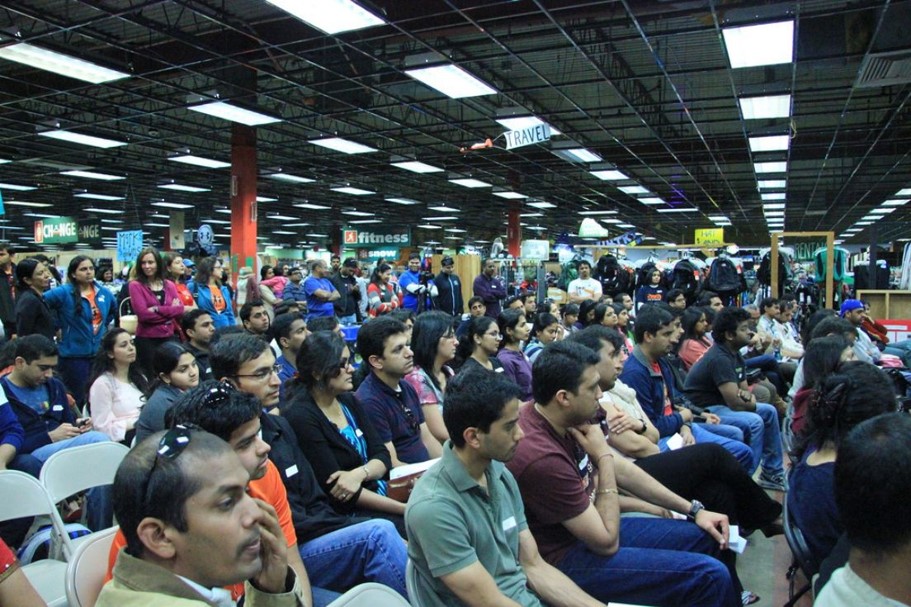
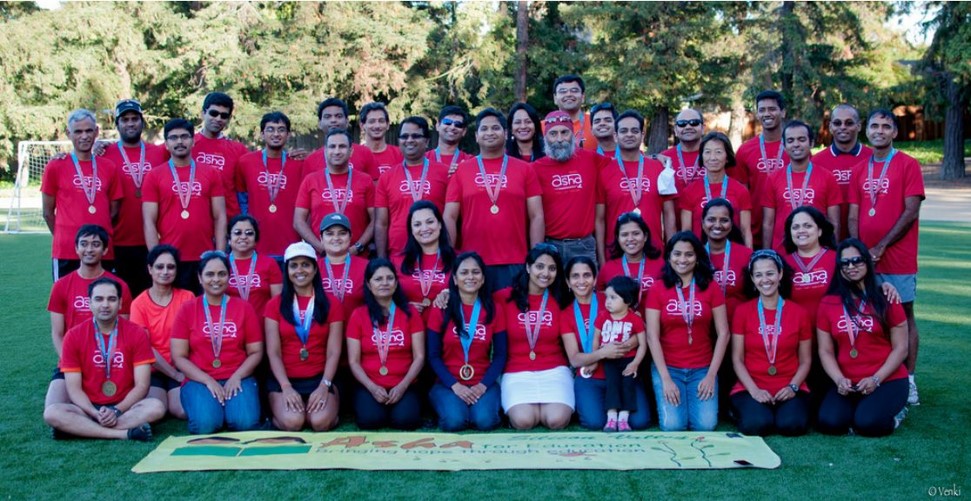
Team Asha Silicon Valley – at the orientation session and after a successful season
Team Asha is Asha for Education’s endurance training program. Various chapters around the US, Europe and India help you train towards your running and biking goals while raising funds for Asha. Visit http//team-asha.org to learn more.
Sahanivasa
Rajeev Annaluru, Asha Boston
Sahanivasa has been working in the Chittoor District of Andhra Pradesh since 1985, organizing Dalits, landless laborers, women and children on a variety of issues, including implementation of land reforms; organizing for minimum wages and tenancy rights; organizing for gender equity and rights; monitoring, documenting and disseminating information about human rights violations and protecting of women’s rights. It also lobbies for changes in existing laws, new laws and implementation of the laws governing these issues.
One of the important initiatives undertaken by Sahanivasa is supporting the education of underprivileged children in its project area. Under this, it runs coaching centers in government schools for primary and high school (9th and 10th grade) students. The educational projects sponsored by Asha Boston involves running 15 primary school and 10 high school coaching centers. All centers use government school infrastructure. The project caters to 1430 students in 15 villages. Apart from the 15 villages with centers, Sahanivasa also actively engages the government school and parent communities in the surrounding villages. As such, the organization reaches schools in 120 villages in Chittoor district.
The area in which Sahanivasa operates is frequently hit by drought, which generally results in seasonal migration of rural landless laborers and small scale farmers to cities in search of livelihood. This results in high dropout in schools, which not only affected the performance of students while they were in school, but also exposed students to the risk of being used as child laborers in the harsh and unforgiving daily wage based urban labor markets. To tackle this problem, Sahanivasa actively ran awareness campaigns in its project area while engaging the village panchayat and government officials to ensure that NREGA (government’s 100-day employment guarantee program) was effectively implemented. Slowly, but surely, Sahanivasa started seeing reduction in the dropout rates of students in schools. In a recent survey, Sahanivasa found that the student enrollment into schools was close to 100% in its project area of 120 villages. There was a 90% reduction in distress migration of agricultural laborers and the dropout rates in schools also came down by close to 90%. In the academic year 2011-12, Sahanivasa achieved an overall 97% pass rate in the 10th grade board exam taken by all the students who attended its coaching centers. Sahanivasa has also been undertaking initiatives to train the teachers and providing them with alternative low-cost science and math kits to improve the quality of education imparted in its coaching centers.
While there has been a great improvement in student enrollment and retention rates in government schools, Sahanivasa recognizes that the government investment in educational infrastructure in remote rural areas is insufficient. While constantly engaging with the district educational authorities, Sahanivasa also started to pursue enrollment of kids in nearby private schools, under the recently passed Right to Education (RTE) Act. Significant challenges remain on this front, since the private institutions are generally not willing to enroll poor children as they perceive this as a loss of revenue to the school.
Sahanivasa took up awareness campaigns to sensitize parents, school administration and communities to ensure an effective implementation of RTE. Raising the participation of Dalits at different levels of the program is one of the important concerns for the project. The project seeks to collaborate with various community based organizations within the state, promoted by Sahanivasa, that will review the entire program once in every six months along with its team.
Volunteer Speak
Thoughts from volunteers across Asha
Shailen Mistry, Asha Los Angeles
It all started when two friends dragged me from class to attend a meeting in Boelter Hall at UCLA back in 1992. I did not know anything about Asha and was not really thinking about how it would impact my life. At the first meeting, I found out a little about the organization. The room had about a dozen young bright-eyed students looking to change the world. The energy was contagious and by the end of the meeting I had volunteered to help out with the Asha LA website. Over time and a lot of long discussions, I learned more about Asha’s core values and principles which instilled a vision in me that I could make a difference even as a student.
After working on the website, I moved to fundraising and publicity. Then I visited India and brought back reports and proposals for some five projects. I went to grad school at UC Berkeley and volunteered with the Asha Berkeley chapter. I also became the Asha-wide webmaster and worked to redesign the website. I spent years volunteering, developing the site including the projects database, donation system, and more. Much of this code base is still used today.
After Berkeley, I joined the Asha Silicon Valley chapter and then the Asha NYC/NJ chapter. I ran the marathon – 26.2 miles – and raised over $6K. Today I am back. a full circle, to Asha LA, where it all started.
Asha introduced me to an amazing group of highly motivated, caring, thoughtful, smart, energetic people that wanted to make a difference in the world. Through Asha, I made friends at UCLA, UC Berkeley, Silicon Valley, New York and other chapters, with whom I am still in touch today. Asha has shaped my life. Through Asha, I think, I have been able to help make a difference for underprivileged children.
Anjana Mohan, Asha St Louis
Early in my volunteer days I visited Kalladka, a hamlet on the way to Mangalore. There, I asked a group of 10th grade children what their ambitions were for their careers. Boys’ responses ranged from lorry driver to brick mason ─ no doubt, they felt that these were the only achievable professions for them. Girls were either too shy to say or had not yet claimed their place in society where they felt they were allowed to have their own ambitions… save one young woman who told me she wanted to be a maid in the city.
After they were done, upon their request, I told them my story of going to study in the US after finishing 12th grade. Then I toured the premises and spent time with the administrators. As I said my goodbyes the next day, that young woman came up to me, hand in hand with her friend. “After seeing that you went all the way to America on your own, we’ve changed our ambition,” she said. “Now we decided that we will also go to the city on our own,” she continued and, as though on behalf of her friend, “and we will have our own maids.”
It struck me how powerful a person can be. My mere presence changed the way these girls perceived their own possibilities. Today, after 14 years of working for Asha, when I leave my infant and young child or stay awake late to do Asha work, I remember that palpable lesson on how a little bit of time and commitment from me can go a long way towards changing lives.
Lalita, Asha Danbury
Aishwarya was my first official introduction to underprivileged families in India. Five years ago, life offered little hope to this teenage girl in a red light area in Pune. She attended a school that was socially disconnected from mainstream society and was beginning to lose interest in education. There were high chances that she would be exploited.
Today, she leads a regular life. What is most fulfilling to me is that she doesn’t need my support any more. As Aishwarya’s donor, I felt empowered: I made a difference. It made me realize that one could achieve so much more by being associated with an organization. It was around then that I read about the strong foundation on which Asha for Education was built on. My interactions with Asha volunteers only reinforced my decision to belong to this volunteer-driven organization. It was the beginning of my efforts towards establishing our chapter, along with a group of like-minded individuals. It is my hope that our chapter will continue to grow stronger in the years to come such that when we look back, we can take pride in the fact that we delivered lasting results through this wonderful organization.
Lok Biradari Prakalp
Ankita Singal, Asha Zurich
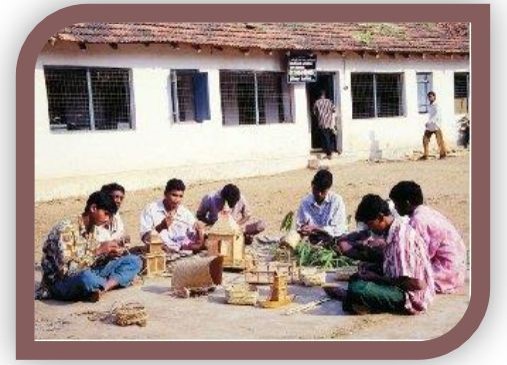
Lok Biradari Prakalp is located deep in the forest region of Hemalkasa, Maharashtra, and has been supported by Asha Zurich since 2011. The school educates upto 600 tribal children of the Madia and Gond tribes. Most of their homes are far away; hence, the school is residential. Asha Zurich funds the day-to-day expenses of the residential facilities for the 100 children. 50 tribal children were admitted to the balwadi (kindergarten) section of the school this year. Many more parents wanted to admit their children but their children could not be admitted due to limited seats.
The students are provided three meals a day. Special attention is given to nutrition. Each student is given a full glass of milk. Moreover, each student receives two sets of uniforms. The library was improved this year to inculcate reading habits in the children. Some books were bought and some were collected from friends and well-wishers. In all, the school collected around 1,500 books.
The school is trying new methods to explore a world that can enrich tribal students and help them define themselves in a better way. For the next academic year, a multi-lingual education program will be introduced for balwadi children – education using their mother tongue for the first two years and then introducing the state language gradually.
The annual celebrations of the school were held on 23-26 December 2012. The school did something different by organizing a scientific fun fair. Students participated with zeal and enthusiasm. They exhibited their skills and knowledge before their parents, who felt proud of these first generation learners. All students had made projects according to their age and abilities. Lok Biradari Prakalp focuses on achieving overall academic excellence and works on establishing a connection between the real world and the academic syllabus. Additionally, a short trip to the riverside was organized for the students. All 600 students were present for the trip.
Asha Zurich bears the full educational and residential cost for 100 students. This includes:
- Bedding – complete set including warm blankets for the winter.
- Stationary – complete study material, pen, pencil, colors, lots of paper and craft material, especially for the lower grades.
- Sports – equipment for athletics, badminton, volleyball, cricket and a modest gymnasium.
A bright student, Sagar Madavi, who comes from a tribal family got admitted for Agricultural Engineering at a renowned University, Rahuri Krushi Vidyapeeth. Quite a few students from this school are studying in other well-known universities. This year, 14 students were selected for state-level sports tournaments in various events. One boy, Jagdish Kudyeti, made it to the national-level and fared well though he did not win medals.
Asha Zurich is very proud of its involvement in this project and wishes all students and teachers success in the coming year.
Shastri School
Site report by Oorja and Apoorva Chowdhary, Junior Asha Seattle
Junior Asha (JA) Seattle is Asha Seattle chapter’s youth wing. It began in 2009. JA kids decided to adopt one of Asha’s projects, Shastri School, as a project to support with their fund raising efforts. All funds raised are sent to the school. Given an appropriate opportunity, JA volunteers also support the local community by volunteering at non-Asha related events. In return they get to talk about Asha’s cause, spread awareness and help support our community.
Shastri School is a home and school for the speech- and hearing-impaired from pre-KG to 10th grade. The project has been supported by Asha since 2000. After volunteering in JA for about a year, we were excited to finally be able to see Shastri School when we visited Bangalore during the last Christmas break. For a long time, we have been wondering how the money that we raised is utilized to help kids of this school, how the kids are progressing and what their upcoming needs are. So we called the school Principal, Mrs Vijaykumari, and organized a time to visit in the morning of 10 January.
When we came into the school, a teacher escorted us into the office. We met the principal there, and she talked to us about how many students and teachers were in the school. She provided an overview of the school and explained the class structures. She informed us that the school taught 1st-10th grades. She then assigned us a 10th grade teacher who gave us a tour of the school.
In the tour, we saw all the classrooms and students. All students had speech and hearing impairment. We learned that these students were provided with completely free education and food. Some of them even lived in the school, on the third floor. All the students greeted us nicely, and some were very excited that they had visitors. The students learn math, science and reading in Kannada, the language of Karnataka. Higher grade students had excellent math skills. One of the students even solved a complex quadratic equation for us on the blackboard. It was interesting to see them learning all subjects ─ math, social studies, history ─ in Kannada. They also communicated using sign language.
All of the kids seemed happy and in good health. The building was larger than I expected. But there were also more kids than I expected; so, the school was crowded. Some rooms had two classes in them and I think that is unacceptable. On the third floor a quarter of the space is taken up by two classes. The remaining space is used for lodging 40 students. It was also sad to see kitchen and restroom next to each other. The good part was students get all three meals of the day and a place to live in.
Once the tour was over, we went back to the office to meet the principal. She told us that their school was benefiting from JA in many ways. The money we donate is used to buy books, backpacks, pencils, uniforms and hearing aids for the students. The secretary, Mr Basavarju, also told us that there were colleges and vocational training schools providing scholarships to the kids so they can find jobs. In the end, we were so happy with the discipline and demeanor of kids that we could not leave without distributing treats to them.
We were very happy to hear how much JA is helping this school. I feel here, in United States, we do not realize how lucky we are to be able to pay for our education and general necessities while some kids in Bangalore need help to pay for these things. We are glad to be part of JA and hope these kids will get the education they deserve. The funds are helping but they do need more. We need to raise the bar and make sure we have more volunteers and creative ideas to raise more funds. This school’s future depends on our help.
A glimpse of events around Asha
Asha Danbury and Asha Berkeley
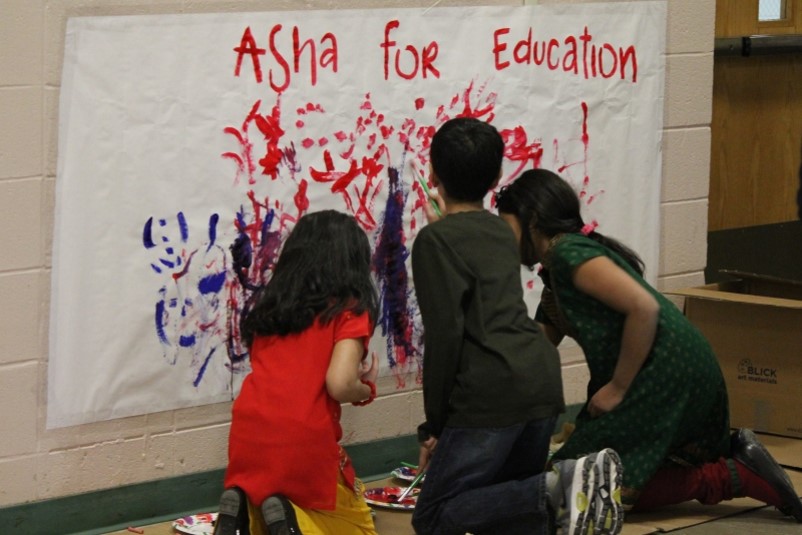
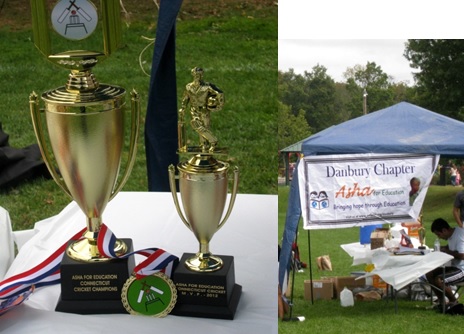
Cricket Tournament
Asha Danbury
Cricket enthusiasts from Hartford, Danbury, Farmington and Middletown converted onto Bartlem Park, Cheshire, CT on 22 September 2012 for the Asha CT cup! More than 55 cricketers gave up their day to help Asha Danbury raise funds for Asha’s project, Mukti. The event and donations from individuals and businesses in Connecticut helped Asha Danbury raise more than $3,600 in two months towards Mukti. The tournament received tremendous encouragement and support from several people, including members of other organizations in CT.
Asha Danbury’s annual fund-raiser was held a few weeks before the 2012 Holi festival. Chapter volunteers presented details of their projects and the progress of this fledgling chapter. It was a colorful evening of fun, music, food and dance for the adults while the children were entertained with puppet-shows, face-painting and arts & crafts.
This two-year-old chapter has now established a firm base in Danbury and is creating awareness around Connecticut!
It’s a Girl: October Film Screening
Asha Berkeley
On Friday, 19 October, Asha Berkeley partnered with another UC Berkeley organization, REACT to Film, to organize a free screening of the 2012 documentary “It’s a Girl”, for Cal students. The film explored critical issues like female infanticide and sex-selective abortion in modern India and China, examining how culture, tradition, and current government policies contribute to gendercide of girls and women today. The free screening served primarily as an awareness event for Asha, especially since Asha Berkeley’s most important fundraiser, Images of India, was in two weeks of the screening. With our partner, REACT to Film, we brought in a good crowd of over 75.
Once the movie was over, many audience members stayed to participate in a lively, informal discussion over the merits of some key points of the film. The impromptu conversation encouraged audience members to think critically about the messages of the film and how to best move forward with solving problems of female infanticide and sex-selective abortions. Hopefully audience members left the event with an awareness of issues relating to gendercide in India and China.
SVYM – Mobile Science Van Project
Melli Annamalai, Asha Boston

SVYM and Asha Boston incubated this pilot program to expand exposure to science subjects in remote communities of HD Kote taluka in Mysore district, Karnataka. The project reaches 9,000 students in 20 schools. Through this project, the Mobile Science Van (Vignana Vahini) provides government school teachers material and equipment needed to demonstrate science experiments and facilitate experiential learning. A vehicle equipped with material such as chemicals and demonstration kits visits schools regularly. Teachers use these to support their science classes. Two trained facilitators travel with the van to help teachers and even teach if a teacher is absent. Teachers have requested science books to be made available in the van. The goal is to improve the understanding of science and instill a culture of scientific thinking among the students.
Achievements: There has been a 40% increase in the number of students choosing the science stream after 10th grade. Having government school teachers engaged in this project and identifying their needs is a big achievement. This is a result of including the teachers as equal partners in the project right from the beginning. Participation in the science fair has increased and the teachers have requested a smaller fair in each school to increase student participation. The government is also beginning to chip in by providing ‘Lab-in-a-Box’ equipment to some schools. A career counseling center has been set up to help students choose subjects in the pre-university classes (PUC) after 10th grade. Two graduates from a teacher training program for youth from the area (funded by Asha San Diego) have been hired. This type of capacity building is essential for long-term and sustained improvement. A weekly 30-minute community radio program discusses science topics and career choices. Short science talks and quizzes have been started at schools that are very popular among the students.
Below are some pictures from the recent science fair organized at one of the schools covered by the project. The plan for 2013 includes additions to the current program focused on high schools, and plans to expand to higher primary schools.
Challenges: As in many innovative educational programs, the project must continually balance the dual goals of fostering excitement and an interest in the sciences along with providing support for more rote lessons geared towards examinations. The project also continues to explore financial options for sustaining and expanding itself.
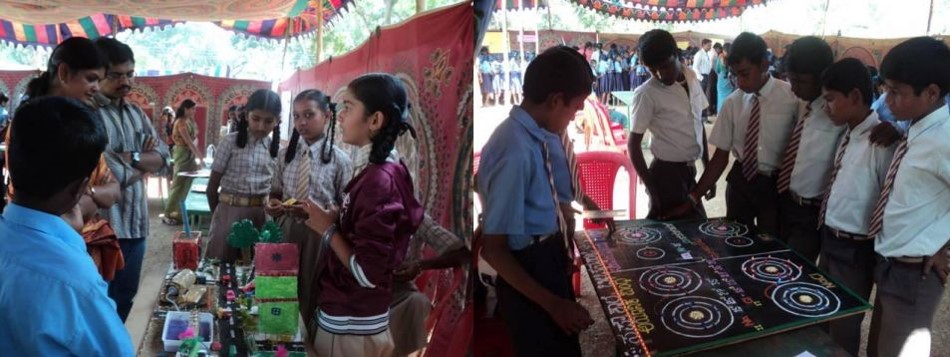
Volunteer Speak
Thoughts from volunteers across Asha
Nikhil Jhadav, Asha Mumbai
When we completed engineering from one of best colleges of India, many of my friends were planning to go abroad to continue their careers. I wanted to stay back in India since I felt the need to serve my country. But I wasn’t sure how I would go about doing it. While pursuing my MTech, I planned to join an NGO and searched for NGOs that are operating in Mumbai. Luckily, my first try was the best: I joined Asha Mumbai in 2007! I started teaching at the Asha Mumbai Center Project, near IIT Mumbai, and I became part of Asha. Now I volunteer for Asha Mumbai in various capacities such as Asha Mumbai webmaster. I do site visits for projects; I help in project preparation and work on any other chapter activities.
Every volunteer in Asha wants to serve society by serving the underprivileged kids. Seeing them put in all the hard work with passion and dedication without expecting anything in return is a very inspiring experience. Every time I interact with the kids in Asha’s projects, it reminds me of my beautiful childhood days and makes me realize all the hope and a better life that we can give those kids. This gets me all charged up and that is what keeps me going.
Namita Gujral, Asha San Francisco
I joined Asha for Education, San Francisco chapter, in 2010 as a project steward. The foremost driving force behind joining this organization was that it offered me a meaningful way to stay connected to my home country. I immediately resonated and aligned with Asha’s mission – to catalyze socioeconomic change in India through education of underprivileged children. It took me some time to fully understand exactly how a large, decentralized global organization has existed (and, in fact, expanded) successfully despite a ‘volunteer-run’ model. I wondered, “How can this be?” Through my relationship with the San Francisco chapter, I soon discovered how and why this is possible.
The backbone of Asha is undoubtedly its 1,000 volunteers ─ sensitive, intelligent, disciplined and highly creative individuals who wholeheartedly believe that life is also about giving back and narrowing the wide chasm between those born and blessed with the gift of education and the millions of those who are not. These individuals are not a part of Asha: They are Asha. Their very deep and honest commitment to Asha’s mission has ensured, and will always continue to ensure, that Asha exists, grows and nurtures itself and the millions of children that it supports. We don’t do “charity”. We simply work hard to eliminate the unfortunate, misplaced and unfair divide between citizens of India, and we do this through education. This is the fundamental, raw spirit that we find in every meeting that we attend; every fundraiser that we organize and every school that we help set up for children in India.
It has been a special bonus that while executing Asha’s mission in the last few years, I have received enormous and very tangible benefits from Asha, in addition to the satisfaction I get from helping deserving children. Through the various activities I have been involved in, I have learnt and used brand new professional skills that have led to wonderful outcomes. Events coordination taught me important project management skills. How can we lead our fundraising event from planning to controlling within the given time-constraints and almost zero cost (we are volunteer-run after all)? Activities include finding and formulating a core team; finding volunteers and allocating tasks based on their interests and availability; finding an attractive but economical venue; finding food and beverage vendors on optimal revenue-sharing terms; event publicity (social media, video/email/affiliate marketing) and post-event tasks (attendee surveys to collect feedback for future events). Hard, honest work. The result? The most fun events that we have organized and attended – SF Dandiya Night, SF Film Festival, SF Half Marathon, to name a few, and some of the best friendships made with each other along the way!
Similarly, being on the opposite side of the equation – projects coordination – has taught me new skills. What should our chapter’s project portfolio look like? What kinds of projects and budgets should we support? How should we align our dollars disbursed with funds raised in a year? How can we encourage our projects to implement scalable components that will maximize the impact of every dollar spent? Which Asha-wide initiatives (e.g., Work-an-Hour) can we find and leverage to fund our chapter’s projects? Important questions, important work, real results. Every time we read the testimonial of a child in a school that we helped set up, we know that every minute of what we do is worth it!
All of this is possible for one main reason – Asha’s democratic, decentralized, non-hierarchical organizational structure. Activities and plans are not just decided by one individual – all chapter members are involved in decision-making. The idea behind having this model is to fuel creativity and encourage volunteers to steer their own ship (no boss telling you what to do!). The results are remarkable – each of us takes serious ownership and responsibility to do things that are good for our chapter’s success and growth. This true spirit of volunteerism will always promise that Asha continues to execute its mission successfully, and that each supported child in India is welcomed into a life of opportunity and respect.
Join Asha and become Asha! You may find that you are getting from it as much, if not more, than you are giving.
Spandan
–Asha Zurich
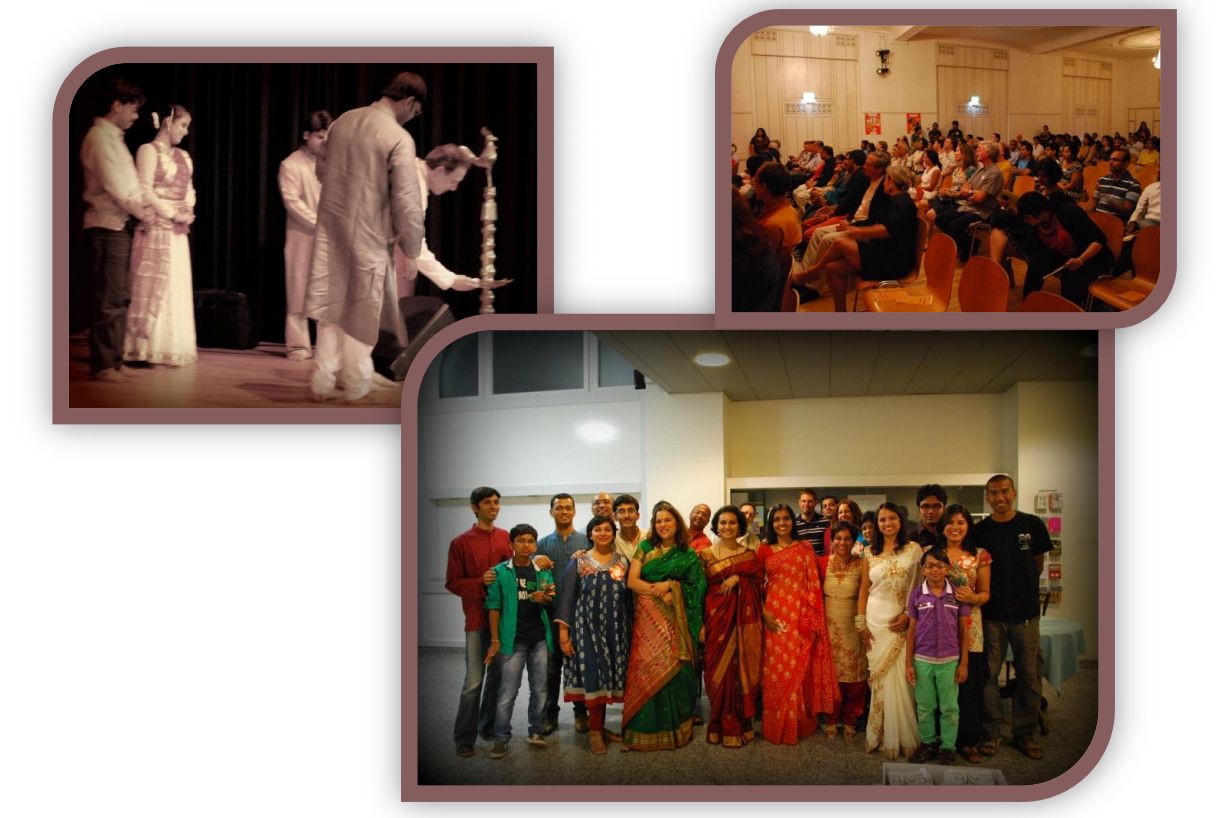
On 25 August 2012, Asha Zurich organized its biggest fund raiser, Spandan, “an evening of Indian music and dance.” Pt Sanjeev Abhyankar, a nationally decorated artist from India, enthralled the audience at Volkshaus Zurich which provided a perfect location for the event. The evening started with a beautiful Kathak performance by Poonam Panchwagh from Zurich. Then we enjoyed a sarod recital by Ken Zuckerman, a very accomplished artist from Switzerland. The evening ended with a mesmerizing performance of classical Indian vocal by Pt Sanjeev Abhyankar and his two accompanists on tabla and harmonium, also from India.
The three-hour program was attended by 200 people who were enthralled. We served homemade Indian snacks at the event. We took the opportunity to showcase Asha Zurich’s work in India by presenting our projects, thus reaching out to a large community in Zurich and soliciting sponsorships. CHF 14,000 were raised which will go a long way towards educating children.
Planning started almost six months before the event. We received full sponsorship from local businesses. 20 past and current volunteers worked day and night to make the event successful. It was a great opportunity for bringing volunteers together and boosting the volunteer spirit.
Self-sustenance of Asha Projects
Ajoy K. Saha, Asha U. Florida and Pradeep Jayaraman, Asha Stanford
In the context of Asha projects, sustainability is the ability of the project to remain functional and generate resources on its own when Asha’s funding ends. At many chapters of Asha for Education we provide seed funds to new education projects for underprivileged children for a few years (usually 3-5 years) and expect projects to generate resources on their own thereafter. This is not easy. However, a few approaches have succeeded.
Almost all projects supported by Asha are run by NGOs as non-profit projects with provision for generating resources internally. Anyway, the products of an educational project are educated children, who cannot generate any revenue until they are adults and employed. Thus it is unobvious how projects can do anything but depend on outside funding. Nonetheless, Asha for Education hosted numerous conference calls during 2012 to discuss various self-sustenance strategies employed by project partners towards this end. Several of the ideas discussed over these calls are outlined below.
A project can run some sort of business and use its proceeds. For example, one of Asha’s projects, Vikasana, (Bhadravati, Karnataka) which runs a school for dropout children, bought land for farming by raising funds through the ‘Work an Hour’ fundraising program in 2007. It took a few years to obtain returns. Reassuringly, for the financial year 2012-13, Vikasana used part of the yield from its farm for school consumption and the rest was sold to generate ₹ 25,000 for operations. Although the progress looks good, it is unsure if this can remain a profitable business in the future, growing and generating sufficient income to cover the bulk of maintenance expenses. Nevertheless, the effort is praiseworthy and the progress is promising.
A very successful idea, implemented at Peoples Action for Transformation (PAT; Tiruchirapalli, Tamil Nadu) is a combined microcredit-child development program. In essence, Asha provided the corpus funds for the microcredit program that provided loans through women-led self-help groups to enable the women to pursue their livelihood. The interest generated through the microcredit program was used to run child development centers that provided early childhood education, care and nutrition to the children of the slums where they operated. The program freed the mothers from the responsibilities of childcare, and provided them credit to be able to generate incomes while the children benefitted from the education and nutrition provided at these centers. This strategy seems to have worked well in the communities served by PAT.
Another promising idea is to develop a school using Asha’s funds, run it well, and demonstrate its usefulness to the community. If the project is indeed adding value to the community, the community will own it and take care of its functioning in the future, that is, collect funds for it. This is exactly what happened to one of the Asha projects, Forum for Women’s Rights and Development (FORWORD; Kancheepuram, Tamil Nadu) which runs several schools for Dalit children in slums. With support from many Asha chapters over the years, FORWORD has developed many schools for underserved slum children during the last ten years. Many of these schools were later adopted by the community and are currently being run with funds raised by the community. It is important to note that it took a long time for the project to achieve success. This is a very good sustainable model for Asha schools, if managed well. This also helps define sustainability as “the ability of the community to sustain the project without any external intervention”, in this case, Asha.
A similar model is used by Sandnya Sanwardhan Sanstha (SSS) which runs a school for disabled children in Nagpur. The project gets only 20% of its funds from Asha while the rest comes from many donors who contribute on a monthly basis. 90% of the donors are individuals and the rest are small businesses. Diversification of the funding sources helps SSS manage fund fluctuations well. Reaching out to the community has helped them gain exposure, respect and a good standing in the area that would now be more keen to sustain the project.
Other ideas include having a team proficient in grant proposal writing to be constantly involved in documenting and submitting proposals to funding agencies across the world. Indian NGOs in remote areas usually lack report and grant writing skillsets although they may be proficient in project development and grassroots level work. For a proposal to be successful, it is very important that it be well articulated and attractive. In this context, we can build a team of highly motivated young professionals who will visit remote villages (as we do in case of site visits), identify good (Asha and non-Asha) projects and offer to write grant proposals for these projects. Better still, the team can train the project authorities in good writing and presentation skills. Moreover, the initial association with Asha and work demonstrated on the basis of Asha’s funding should help projects present their proven ability and efficiency with credibility.
Parenthetically, we must keep in mind that while these and other business strategies can generate funds, these can also divert attention from the projects’ main foci resulting in inefficient practices.
In summary, achieving sustainability is inherently difficult for Asha projects. It will take a long time to achieve such a status. It is unlikely that a single NGO can do it on its own. Much effort and outside support will be required to make a project sustainable. The role of Asha should not be to push the project partner towards a solution but to present them with options and help them find their own sustainable models of operation. Community education to help communities realize the value of these projects and sustain them locally may be the key.
Financial Reports
Asha-wide Treasury Team
Starting 2012, Asha for Education has independent audit reports of it’s finances. In 2012, the accounting was on a Cash-basis. Detailed financial reports of Asha, including a copy of the report by an independent auditor, can be found here.
Statement of Activities
| Support and Revenues | Unrestricted | Temporarily Restricted | Total |
| Contributions | $2,864,090 | $192,544 | $3,056,634 |
| Special event revenue | $167,606 | $167,606 | |
| Less: Cost of Benefit to Donors | ($170,575) | ($170,575) | |
| Merchandise Sales | $1,895 | $1,895 | |
| Interest Income | $66,732 | $66,732 | |
| Net assets released from restriction | $144,081 | ($144,081) | – |
| Total support and revenues | $3,073,829 | $48,463 | $3,122,292 |
| Expenses | |||
| Program Services | $1,901,300 | $1,901,300 | |
| Management and General | $20,571 | $20,571 | |
| Fundraising | $35,396 | $35,396 | |
| Total Expenses | $1,957,267 | $1,957,267 | |
| Change in Net assets | $1,116,562 | $48,463 | $1,165,025 |
| Net assets, beginning of year | $7,454,796 | $7,454,796 | |
| Net assets, end of year | $8,571,358 | $48,463 | $8,619,821 |
Income and Expense Details – Overall
The following graphs show the sources of our income and main expenses. Net income from fundraisers and investments form only 2% of our total income while 98% of the income is from tax-exempt donations, including the donations at fundraising events. On the expense side, 97% of our funds are used to support projects in India. Administrative and fundraising expenses account for only 2.86% of the total expenses – a majority of which is towards credit card processing and bank charges.
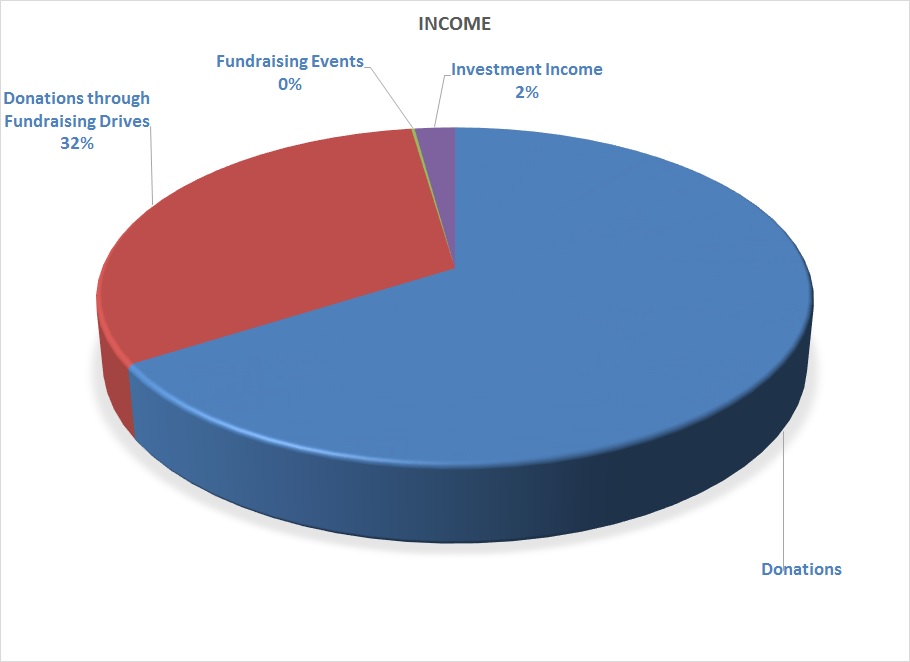
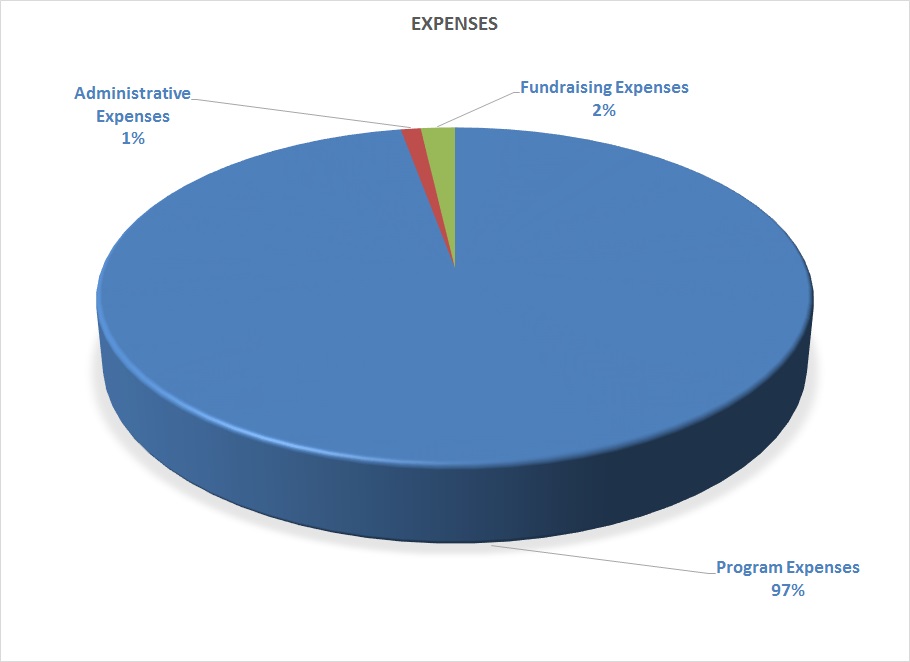
Statement of Functional Expenses
| Program Services | Management and General | Fundraising | Total Expenses | |
| Project Disbursement | $1,901,300 | $1,901,300 | ||
| Accounting Fees | $279 | $279 | ||
| Administrative Expenses | $12,760 | $12,760 | ||
| Advertising | $672 | $672 | ||
| Bank Charges | $4,936 | $4,936 | ||
| Credit Card processing fees | $23,660 | $23,660 | ||
| Equipment rental | $6,612 | $6,612 | ||
| Merchandise | $4,263 | $4,263 | ||
| Postage and shipping | $1045 | $1045 | ||
| Printing and publications | $189 | $189 | ||
| Travel | $104 | $104 | ||
| Total Expenses | $1,901,300 | $20,571 | $35,396 | $1,957,267 |
Contact Info
BOARD OF DIRECTORS
| President | Rajeev Annaluru | president@ashanet.org |
| Secretary | Nikhil Bojja | secretary@ashanet.org |
| Treasurer | Sreerama Jayanthi | treasurer@ashanet.org |
| Director, Projects | Pradeep Jayaraman | projects@ashanet.org |
| Director, Web | Vyas Sanzgiri | webmaster@ashanet.org |
| Director, PR | Alivia Sil | pr@ashanet.org |
ANNUAL REPORT TEAM
Prerana Thakurdesai, Pradeep Jayaraman and Pabitra Chatterjee. Proofreading by Venkatesh Iyengar.
Thanks to all volunteers who contributed articles, photographs and other content for the Annual Report. We would also like to thank every member of Asha for Education for their valuable inputs and suggestions.
